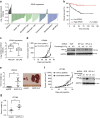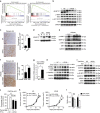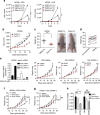Epigenetic re-expression of HIF-2α suppresses soft tissue sarcoma growth
- PMID: 26837714
- PMCID: PMC4742834
- DOI: 10.1038/ncomms10539
Epigenetic re-expression of HIF-2α suppresses soft tissue sarcoma growth
Abstract
In soft tissue sarcomas (STS), low intratumoural O2 (hypoxia) is a poor prognostic indicator. HIF-1α mediates key transcriptional responses to hypoxia, and promotes STS metastasis; however, the role of the related HIF-2α protein is unknown. Surprisingly, here we show that HIF-2α inhibits high-grade STS cell growth in vivo, as loss of HIF-2α promotes sarcoma proliferation and increases calcium and mTORC1 signalling in undifferentiated pleomorphic sarcoma and dedifferentiated liposarcoma. We find that most human STS have lower levels of EPAS1 (the gene encoding HIF-2α) expression relative to normal tissue. Many cancers, including STS, contain altered epigenetics, and our findings define an epigenetic mechanism whereby EPAS1 is silenced during sarcoma progression. The clinically approved HDAC inhibitor Vorinostat specifically increases HIF-2α, but not HIF-1α, accumulation in multiple STS subtypes. Vorinostat inhibits STS tumour growth, an effect ameliorated by HIF-2α deletion, implicating HIF-2α as a biomarker for Vorinostat efficacy in STS.
Figures






Similar articles
-
Hypoxia-inducible factor-1alpha and hypoxia-inducible factor-2alpha are expressed in kaposi sarcoma and modulated by insulin-like growth factor-I.Clin Cancer Res. 2006 Aug 1;12(15):4506-14. doi: 10.1158/1078-0432.CCR-05-2473. Clin Cancer Res. 2006. PMID: 16899596
-
Hypoxia and hypoglycaemia in Ewing's sarcoma and osteosarcoma: regulation and phenotypic effects of Hypoxia-Inducible Factor.BMC Cancer. 2010 Jul 16;10:372. doi: 10.1186/1471-2407-10-372. BMC Cancer. 2010. PMID: 20637078 Free PMC article.
-
Differential roles of Sirt1 in HIF-1α and HIF-2α mediated hypoxic responses.Biochem Biophys Res Commun. 2014 Jan 31;444(1):36-43. doi: 10.1016/j.bbrc.2014.01.001. Epub 2014 Jan 11. Biochem Biophys Res Commun. 2014. PMID: 24423936
-
Progress on hypoxia-inducible factor-3: Its structure, gene regulation and biological function (Review).Mol Med Rep. 2015 Aug;12(2):2411-6. doi: 10.3892/mmr.2015.3689. Epub 2015 Apr 27. Mol Med Rep. 2015. PMID: 25936862 Review.
-
Mechanisms Leading to Differential Hypoxia-Inducible Factor Signaling in the Diabetic Kidney: Modulation by SGLT2 Inhibitors and Hypoxia Mimetics.Am J Kidney Dis. 2021 Feb;77(2):280-286. doi: 10.1053/j.ajkd.2020.04.016. Epub 2020 Jul 23. Am J Kidney Dis. 2021. PMID: 32711072 Review.
Cited by
-
Nanotheranostics Targeting the Tumor Microenvironment.Front Bioeng Biotechnol. 2019 Aug 14;7:197. doi: 10.3389/fbioe.2019.00197. eCollection 2019. Front Bioeng Biotechnol. 2019. PMID: 31475143 Free PMC article. Review.
-
Epigenetics of Cutaneous Sarcoma.Int J Mol Sci. 2021 Dec 31;23(1):422. doi: 10.3390/ijms23010422. Int J Mol Sci. 2021. PMID: 35008848 Free PMC article. Review.
-
SINHCAF/FAM60A and SIN3A specifically repress HIF-2α expression.Biochem J. 2018 Jun 29;475(12):2073-2090. doi: 10.1042/BCJ20170945. Biochem J. 2018. PMID: 29784889 Free PMC article.
-
Bioinformatics Analysis Identifies EPAS1 as a Novel Prognostic Marker Correlated with Immune Infiltration in Acute Myeloid Leukemia.Dis Markers. 2023 Apr 17;2023:6072782. doi: 10.1155/2023/6072782. eCollection 2023. Dis Markers. 2023. PMID: 37124944 Free PMC article.
-
Recent Advancement in Atypical Lipomatous Tumor Research.Int J Mol Sci. 2021 Jan 20;22(3):994. doi: 10.3390/ijms22030994. Int J Mol Sci. 2021. PMID: 33498189 Free PMC article. Review.
References
-
- Fletcher C. D. The evolving classification of soft tissue tumours—an update based on the new 2013 WHO classification. Histopathology 64, 2–11 (2014). - PubMed
-
- Siegel R., Ma J., Zou Z. & Jemal A. Cancer Statistics, 2014. CA Cancer J. Clin. 64, 9–29 (2014). - PubMed
-
- Linch M., Miah A. B., Thway K., Judson I. R. & Benson C. Systemic treatment of soft-tissue sarcoma-gold standard and novel therapies. Nat. Rev. Clin. Oncol. 11, 187–202 (2014). - PubMed
Publication types
MeSH terms
Substances
Grants and funding
LinkOut - more resources
Full Text Sources
Other Literature Sources
Medical
Molecular Biology Databases

